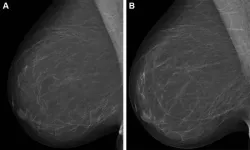(Press-News.org) Scientists at Rice University in Houston, Texas have developed a fabric-based wearable device that “taps” a user’s wrist with pressurized air, silently helping them navigate to their destination. The study, published August 29 in the journal Device, demonstrated that users correctly interpreted which direction the device was telling them to go an average of 87% of the time. Since the wearable embeds most of its control system within the fabric itself, using air instead of electronics, it can be built lighter and more compact than existing designs.
“We envision this device will be used by individuals who need or desire information to be transmitted to them privately and in a way that can be seamlessly integrated into clothing or other wearables,” said Marcia O’Malley (@MarcieOMalley), Chair of the Department of Mechanical Engineering at Rice University and an author of the study.
The wearables may benefit amputees who use prosthetic limbs, people with hearing loss, and specialists such as surgeons, pilots, and soldiers who are inundated with visual and auditory information.
Visual and auditory cues like a flashing light on a dashboard or the ping of a new text message can effectively transmit information. However, many people are overwhelmed by such cues in their daily lives—and with too many notifications conveyed the same way, information can get lost in the clutter. “Haptics,” or touch-based stimuli, which include hot or cold sensations or cues based on pressure applied to the skin, can offer an alternative.
But while devices that produce visual cues or sounds are prevalent in everyday life, devices that use haptic cues are still uncommon since they usually require bulky hardware that weighs down the wearer.
To overcome this obstacle, the Rice University researchers developed a light, comfortable wearable device from textile materials that can be worn on a user’s arm. The team tested the device by measuring forces applied to the user as a function of pressure and the shape of the wearable—a task that proved somewhat challenging since different users had different experiences with cues from the same device, said Barclay Jumet (@JUMETkinmecrazy), a PhD candidate in mechanical engineering and the lead author of the study.
“Every person has a differently shaped arm, a different perception of what “feels good” in terms of the forces applied and the timing of the forces, and different capabilities in responding to the type of haptic cues we delivered,” said Jumet. “Fortunately, our textile-based platform is easily tailorable and adjustable to a range of body types and sizes.”
After testing the performance of their haptic textile sleeves in a lab-based study involving human participants, the researchers set out to see how well these devices could help users navigate in a real-world scenario. They integrated two of the sleeves into a shirt and completed the ensemble with a textile belt where they attached auxiliary components, making the device portable. Next, an experimenter sent cues to the user wearing the device, directing them where to walk for one kilometer.
“We were impressed that the user was able to navigate the streets of Houston and subsequently trace 50-meter-long Tetris pieces on an open field with 100% accuracy in receiving and interpreting navigational haptic cues,” said Daniel Preston (@ProfDanPreston), an assistant professor of mechanical engineering and the corresponding author of the study.
In another navigation test, the participant again interpreted the cues with total accuracy, this time while riding an electric scooter over paved bricks, concrete sidewalks, and graveled paths.
“Further development will seek to improve the ability to convey even more complex cues that remain easily and naturally discerned by the user,” said Preston.
###
This work was supported by the National Science Foundation, Rice University, and the Gates Millennium Scholars Program.
Device, Jumet et al. “Fluidically programmed wearable haptic textiles” https://www.cell.com/device/fulltext/S2666-9986(23)00083-2
Device (@Device_CP), is a physical science journal from Cell Press along with Chem, Joule, and Matter. Device aims to be the breakthrough journal to support device- and application-oriented research from all disciplines, including applied physics, applied materials, nanotechnology, robotics, energy research, chemistry, and biotechnology under a single title that focuses on the integration of these diverse disciplines in the creation of the cutting-edge technology of tomorrow. Visit http://www.cell.com/device/home. To receive Cell Press media alerts, contact press@cell.com.
END
About The Study: The results of this study of 61,000 mother-child dyads suggest that postnatal selective serotonin reuptake inhibitor (SSRI) treatment was associated with a reduced risk of postnatal depression–associated maternal mental health problems and child externalizing behaviors across early childhood years. These findings suggest that postnatal SSRI treatment may bring benefits in the long term to women with postnatal depression and their offspring.
Authors: Chaoyu Liu, M.D., Ph.D., of King’s College in London, is the corresponding author.
To access the ...
About The Study: In this study of primary care patients in a state with legal recreational cannabis use, cannabis use disorder (CUD) was common among patients who used cannabis. Moderate to severe CUD was more prevalent among patients who reported any nonmedical use. These results underscore the importance of assessing patient cannabis use and CUD symptoms in medical settings.
Authors: Gwen T. Lapham, Ph.D., M.P.H., M.S.W., of the Kaiser Permanente Washington Health Research Institute in Seattle, is the corresponding author.
To access the embargoed study: Visit our For The Media website at this ...
UNDER EMBARGO UNTIL 11:00 A.M. EDT ON TUESDAY, AUGUST 29, 2023
Social media’s effects on propagating misinformation among the lay public are widely debated, but a new paper from JAMA suggests physicians using social media are revolutionizing medical education.
La Jolla, Calif. (August 29, 2023) — Ever wonder what your doctor is doing on social media? A new study published in JAMA led by John W. Ayers, Ph.D., from the Qualcomm Institute within the University of California San Diego, finds some physicians are harnessing the reach ...
New research led by the Institute of Psychiatry, Psychology & Neuroscience (IoPPN) at King’s College London has found that selective serotonin reuptake inhibitor (SSRI) treatment for postnatal depression is associated with improvements in child behaviour up to five years after childbirth.
Up to 15% of women experience postnatal depression which has been shown to be associated with poor outcomes for mothers’ and their children. Researchers at King’s IoPPN, in collaboration with the University of Oslo, analysed data from ...
CORVALLIS, Ore. – In northern Yellowstone National Park, saplings of quaking aspen, an ecologically important tree in the American West, are being broken by a historically large bison herd, affecting the comeback of aspen from decades of over-browsing by elk.
Findings of the research led by Luke Painter of Oregon State University were published today in Ecology and Evolution.
The study comes five years after Painter, who teaches ecology and conservation in the OSU College of Agricultural Sciences, published a paper in Ecosphere showing that wolf reintroduction in Yellowstone had been a catalyst for aspen recovery both outside and ...
INDIANAPOLIS -- LOINC® from Regenstrief Institute is issuing its semiannual content update with 1,945 new concepts to help health systems, laboratories and other health organizations exchange medical data. The release contains newly created content based on requests submitted by stakeholders from more than 100 countries.
LOINC version 2.75 is available for download from the LOINC website and via the LOINC Terminology Service using HL7® FHIR®. The updated version includes new, edited and newly mapped concepts ...
Jason Yang has been awarded nearly $400,000 from the National Institute on Aging to explore the role of lifestyle physical activity (light movements, walking) in cognition among insufficiently active older adults with higher risks for Alzheimer’s or related dementias. The exercise science assistant professor will use the two-year R21 grant to help determine if frequent and regular engagement in lifestyle physical activity over time may benefit cognitive function for this population.
A ...
Sleep is a critical part of a child’s overall health, but it can also be an important factor in the way they behave.
According to a new study from the Youth Development Institute at University of Georgia, getting enough sleep can help children combat the effects of stressful environments.
“Stressful environments are shown to make adolescents seek immediate rewards rather than delayed rewards, but there are also adolescents who are in stressful environments who are not impulsive,” said lead author Linhao Zhang, a fourth-year doctoral student in UGA’s College of Family and Consumer Sciences. “We looked at what explains that link and what makes some people ...
Abdominal aortic aneurysm (AAA), a common degenerative vascular disease, particularly afflicts men over the age of 60, with up to 8% affected. Characterized by the abnormal dilation of the abdominal aorta, AAA risks a potentially fatal rupture. Despite increasing research efforts, effective pharmaceutical strategies to curb aneurysm growth remain elusive.
In a study published in the journal of Genes & Diseases, researchers from Sant Pau Hospital Research Institute and Biomedical Research Institute Sant Pau scrutinized the Wnt signaling pathway's deregulation in human abdominal aortic aneurysm (AAA). This ...
OAK BROOK, Ill. – Combining artificial intelligence (AI) systems for short- and long-term breast cancer risk results in an improved cancer risk assessment, according to a study published in Radiology, a journal of the Radiological Society of North America (RSNA).
Most breast cancer screening programs take a one-size-fits-all approach and follow the same protocols when it comes to determining a woman’s lifetime risk of developing breast cancer. Using mammography-based deep learning models may improve the accuracy of breast cancer risk assessment and can also lead to earlier ...






